A Deep Dive Into The RIDGE Label
Blog Post
Ridge Vineyards was founded in 1962 as a partnership by four Stanford Research Institute engineers; Dave Bennion, Hew Crane, Charlie Rosen, and Howard Ziedler.
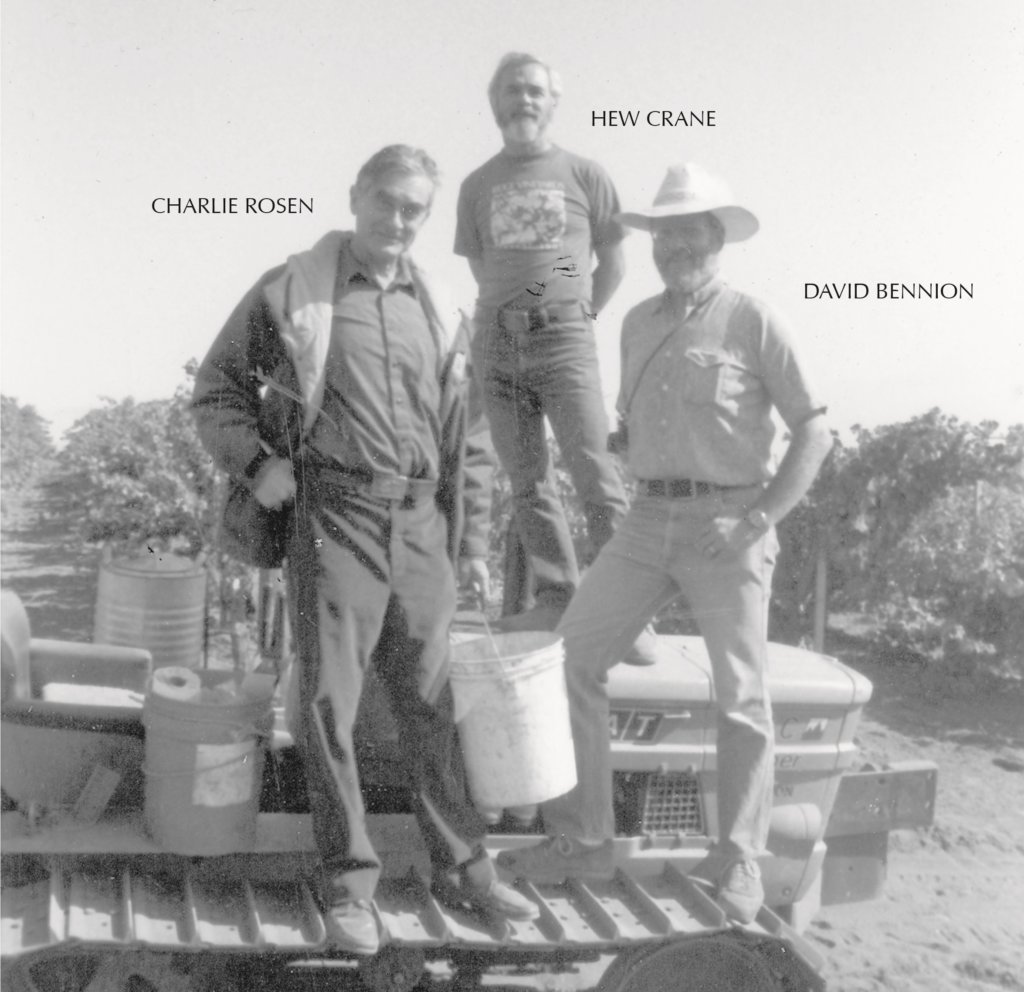
These excerpts were taken from an interview with the founders conducted on March 9th, 1993.
“It was in early 1964 that we started to think seriously about a label for the first wines. Dave and Fran (Bennion) had met a San Francisco architect who recommended a young commercial artist, Jim Robertson. He was enthusiastic about designing a wine label. Maybe more important, he agreed to take his fee in wine. Fran and Sue made several trips to San Francisco and he spent a Saturday on the ridge with us to get to know us better. During this time we were compiling lots of different names for the winery. One was “El Camino Vino,” our joke name. We wanted a name that would distinguish us from a valley winery, that hinted at where we were. We also wanted a clean label, with no pictures, no curlicues, no fancy words, nothing French or German. Also, we wanted a label to be informative. We were ahead of our time in emphasizing completeness and honesty with a wine label. Ridge Vineyards was a good choice. It was easy to say and it described our location. Jim Robertson liked it too, and he suggested that we use Optima type font. It had just been developed in Germany, but we were the first on the West Coast to use it. It has since become very popular. Our label for the 1962 Cabernet won an award for industrial design.”
Hew Crane
“We were concerned about what we saw happening in California with wine. We talked a lot about the honesty factor. We were going to make an honest label, and all the information that a real wine lover would want was going to be on it. We were going to tell where the grapes came from, how much of each, how the wine was made. That’s one of the reasons we ended with the big double label, to get everything on it we wanted.”
Charlie Rosen
For $495 (33 hrs X $15/hour) worth of wine the partners had their label design. It was clean, in the spirit of the mid-century modern aesthetic of the time and presented information about the wine in a straightforward easy to read style the founders were looking for.
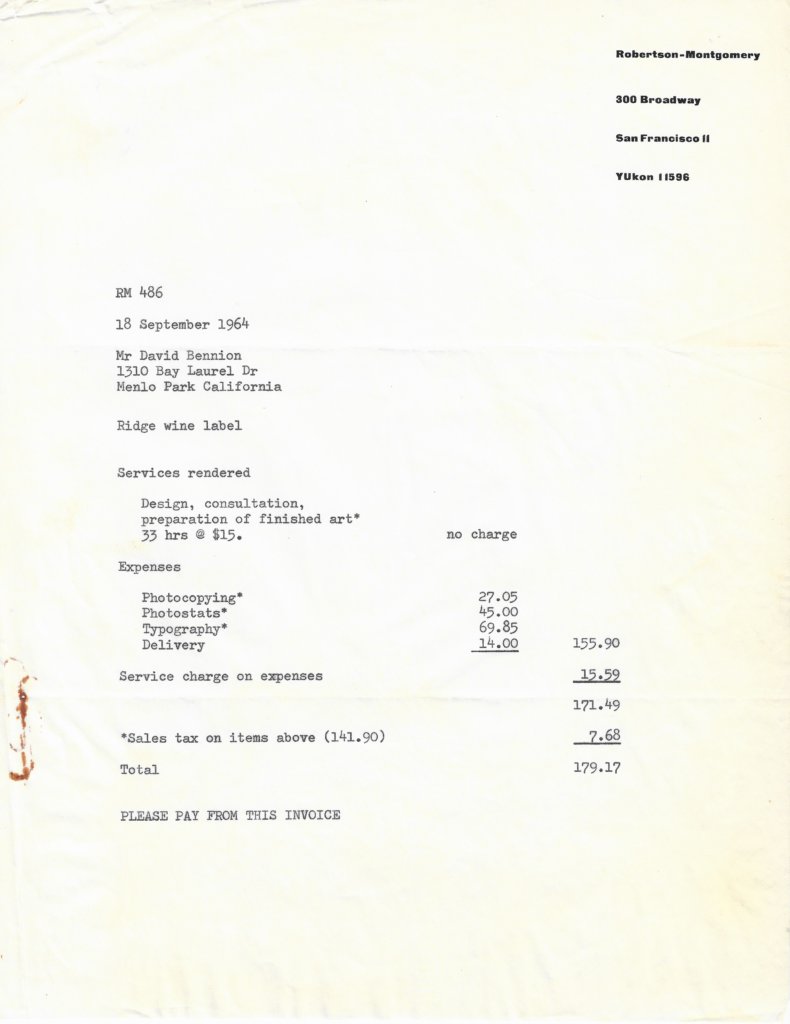
The result is seen below with the label for the 1962 Ridge Cabernet Sauvignon; grown, produced and bottled at Monte Bello. The term Monte Bello was not used because the trademark was still controlled at the time by the corporate decedent of Osea Perrone’s Montebello Wine Company. Happily, a number of years later Ridge gained control of the Monte Bello trademark.
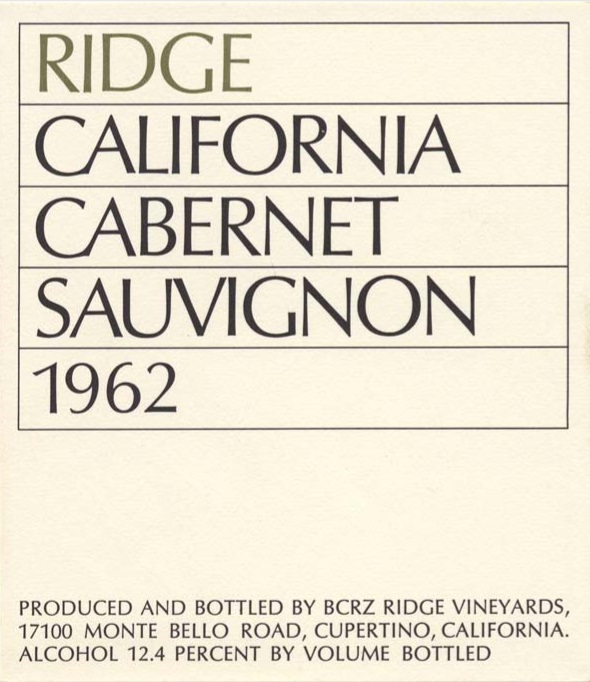
More than 50 years later we are proud to continue to use Jim Robertson’s design elements for our labels while adhering to our founder’s philosophy of providing the customer with useful information about the wine. There is no other label in the industry like it, and it makes it easy for our customers to instantly recognize a bottle of our wine.
For those of you interested in the details, here is a guide to the information provided on our label.
FRONT LABEL
The front label is composed of two main elements – the “Top Block” and the “Bottom Block” The Top Block is the most prominent portion of the Ridge label and is used to quickly establish the identity of the wine for the customer. Key elements of the Top Block include the Ridge brand, the vintage, as well as a designation for the wine. The Bottom Block provides additional facts about the wine.
TOP BLOCK – Overview
The 2013 Estate Cabernet label below shares much in common with the original 1962 label. In this example the Top Block is composed of four lines of text with each element explained in detail below.
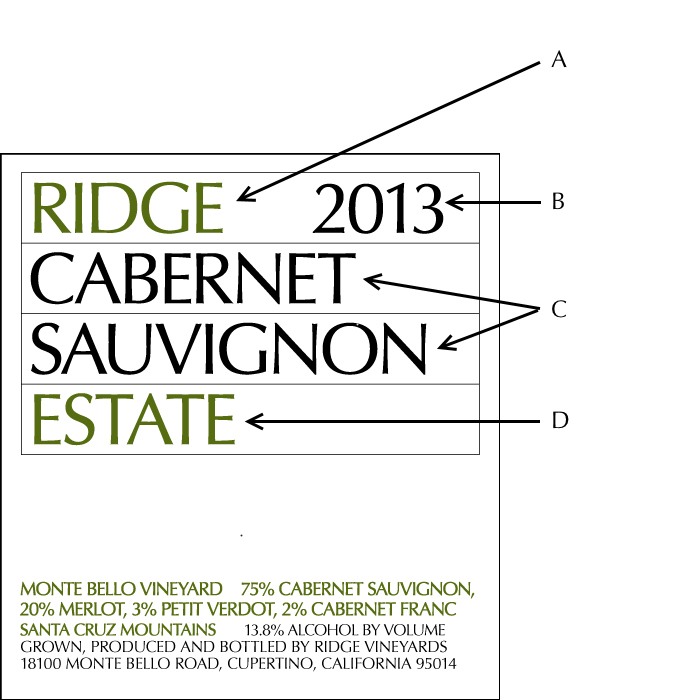
- (A) Brand Name: The first element of the Top Block is always the word RIDGE. In addition to clearly identifying this as a wine made by RIDGE, the fact that this element of the label has remained unchanged for over 50 years results in a very strong branding for Ridge and our wine. This use of Ridge also fulfills the TTB requirement for a Brand Name to be present on the front label. Note that the word RIDGE by itself is a trademark of Ridge Vineyards.
- (B) Vintage Year: Although originally on the last line of the top block the vintage year was moved to the first line for better visual balance and is always the same distance from the word RIDGE regardless of the length of the other elements of the Top Block. Note that per TTB regulations at least 95% of the grapes used to make the wine must be harvested in the vintage year.
- (C) Grape Variety: We use the primary grape variety in the Top Block when 1) the wine contains at least 75% of that variety per TTB regulation and 2) we have chosen not to use a proprietary name for the wine.
- (D) Estate: A wine will carry the Estate designation in the top block when 1) 100% of the grapes used to make the wine are grown on land that Ridge owns or leases and is in the same AVA as the winery location per TTB regulation and 2) we have chosen not to use another descriptive term or proprietary name for the wine.
TOP BLOCK – Vineyard Name
As Ridge’s focus has been, and will continue to be, the production of single vineyard wines, we will often base the identity of the wine on the name of the vineyard where the grapes are grown. In the label below, York Creek is the name of the vineyard. The TTB requires that 95% of the grapes used to make the wine must come from the named vineyard and that the name used is the one currently found on official maps of the vineyard. In some cases we have chosen to use a historical name for the vineyard, in which case the TTB will consider it to be a Proprietary Name (see TOP BLOCK – Proprietary Name below).
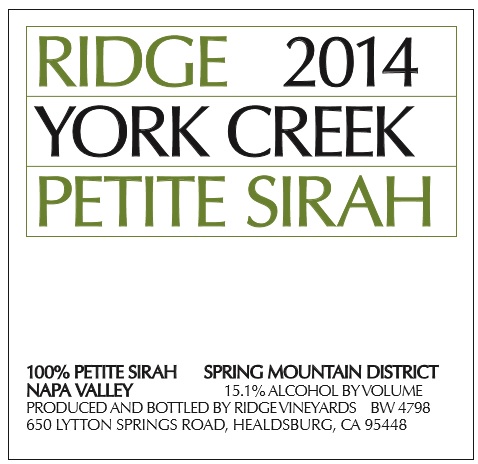
TOP BLOCK – Proprietary Name
The label below is an example where the proprietary name Three Valleys is used as the designation for the wine in the Top Block. When Ridge uses a proprietary name in the Top Block, in most cases we will not include a grape variety in the Top Block. This allows for the production of a wine in which no single varietal must account for 75% or more of the wine. In the example below we have chosen to add the Sonoma County AVA to the Top Block to further inform the customer as to the origin of the grapes used to make the wine.
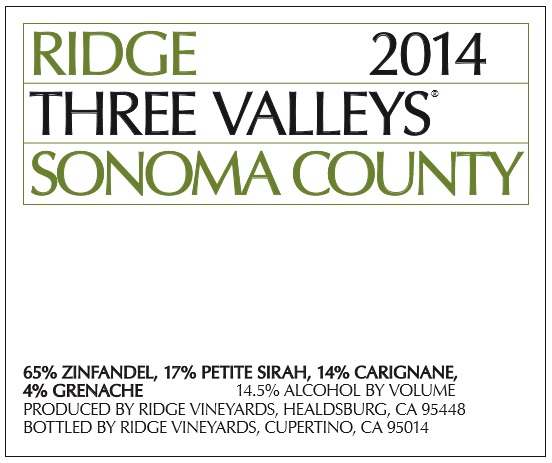
TOP BLOCK – AVA
AVA stands for American Viticulture Area. These areas are defined by the TTB for the purpose of providing consumers with information about where wine grapes are grown in the United States. The label below is an example where the AVA, Paso Robles, is used as the designation for the wine in the Top Block. Ridge uses an AVA in the Top Block if the wine is made from grapes from multiple vineyards within the AVA, or as in the case of Paso Robles if the AVA provides for a stronger identity for the wine.
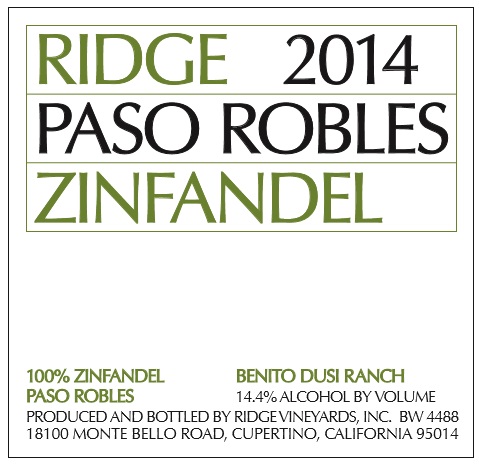
BOTTOM BLOCK – Overview
Ridge uses the Bottom Block to provide additional information about the wine. Some of this information is required by the TTB to be on the front label, while other information is presented to give the customer more information about the wine.
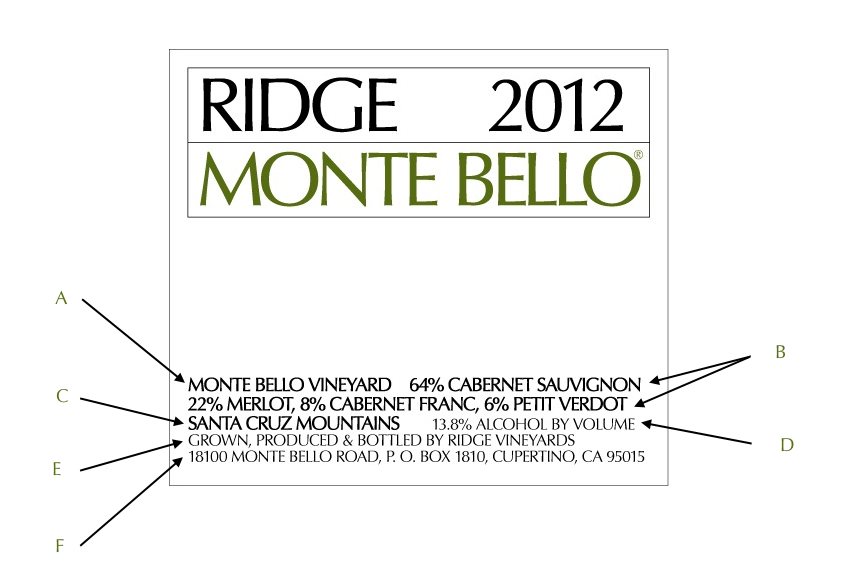
- (A) Vineyard Name – For single vineyard wines we include the name of the vineyard on the first line of the Bottom Block.
- (B) Grape Varieties(s) – We use the Bottom Block to list all of the varietals used to make the wine and show the percentage each one contributes to the blend. If only one varietal is used it is listed as 100%.
- (C) AVA – We always try to include the most specific AVA in which the grapes were grown for this wine. We will include the AVA in the Bottom Block even if it is also used in the Top Block. See the Paso Robles label above in the Top Block examples.
- (D) Alcohol by Volume – Wine labels must list the percentage of alcohol in the wine per TTB regulations. Ridge’s policy is to use the most accurate measurement possible even though the regulations allow for a variance of +/- 0.5%
- (E) Production Statement – If Ridge has grown the grapes then the statement will be “Grown, Produced, and Bottled by Ridge Vineyards” as on the Monte Bello label above. If Ridge purchased the grapes then the statement will simply be “Produced and Bottled by Ridge Vineyards” Because Ridge always crushes, ferments, ages, and bottles its wines itself this statement makes it clear that the wine was not made by someone else. These statements are closely regulated by the TTB.
- (F) Address – This is the address of the winery where the wine was produced. The address shown above is for the Monte Bello winery. If the wine was made at Lytton Springs then that address would be used.
BACK LABEL
The Back Label is used to provide a short description by the winemaker of what unique or important events occurred that contribute to the unique character of the vintage as well as other important information including a number of items required by the TTB.
The following example shows the different elements used on the Back Label of the 2012 Monte Bello which is generally representative of all Ridge Back Labels.
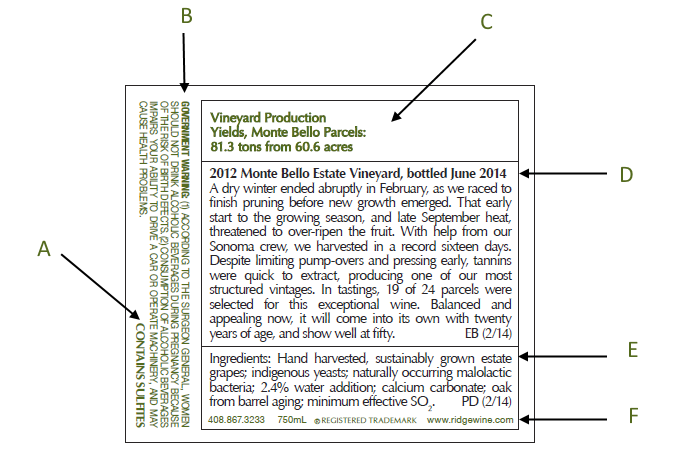
- (A) Allergy Warning – Per TTB regulation all wine must contain the Allergy warning “Contains Sulfites”. Further, if a winery chooses to include an ingredient list on the label, as we do at Ridge, then we must include an allergy warning for an additional list of allergens established by the FDA if any of those allergens are used in the production of the wine. Given the way Ridge makes its wine, the only other allergy warning we might have to include is the statement “Contains Egg” if we have used egg whites for fining.
- (B) GOVERNMENT WARNING – The exact government warning statement shown on this label must be used on all wine labels per TTB regulation.
- (C) Production Information – The top block on the back label is sometimes used to give the customer more information about the quantity of wine made. For Monte Bello we have traditionally indicated the size of the “selection” from the Monte Bello vineyard as well as the yield. In recent years we have done this by indicating the total tons of grapes selected and the number of acres they were grown on. For some of our very small production wines we will simply state the total number of barrels of wine produced. For other wines we will simply leave this top block blank.
- (D) Wine and Vintage Description – This is where the winemaker can tell a short story about the wine and the nature of the vintage. The paragraph always starts with the vintage year and the name of the wine followed by the month and year it was bottled. The text usually ends with an estimate of the aging potential for the wine. An in depth discussion of this element of the back label is provided below.
- (E) Ingredients – Starting with the 2011 vintage Ridge has included an ingredient list on the back label. All ingredients that are used in the production of the wine are listed in keeping with Ridge’s desire to provide the customer with as much information about the wine as possible. While wineries are currently not required to have a list of ingredients on their label, if you choose to include such a list there are a strict set of rules and regulations that must be followed. The following is the list of ingredients found in every Ridge wine and the exact wording that we use for each:
- Grapes
- Hand harvested
- Sustainably Grown or Organically Grown* (as applicable)
- Estate (when applicable)
- Indigenous yeasts
- Naturally occurring malolactic bacteria
- Oak from barrel aging
- SO2 (The phrase minimum effective was used until 2019 when the TTB ruled we could no longer use it.
- Grapes
*Grapes must be 100% certified organic in order to make the statement “organically grown.”
The following is a list of ingredients that are only sometimes used during winemaking at Ridge and included in the ingredient list when used:
- % Water Addition
- Calcium Carbonate
- Tartaric Acid
- (F) Additional Information – On this line we include our telephone number (same number since the beginning), the size of the bottle, trademark notice and web address.
Wait!
In order to qualify for user related discounts, you must log in before proceeding with checkout. Click the button below to log in and receive these benefits, or close the window to continue.
Log In